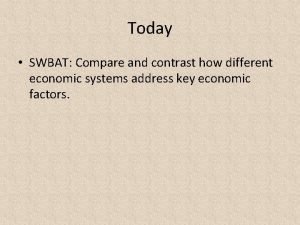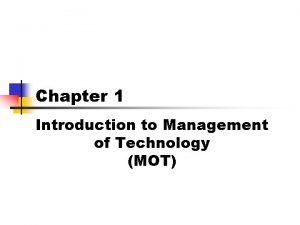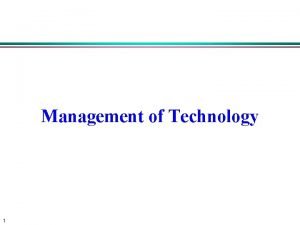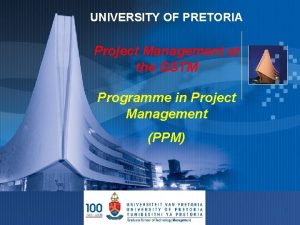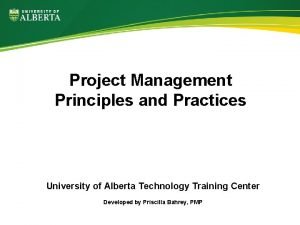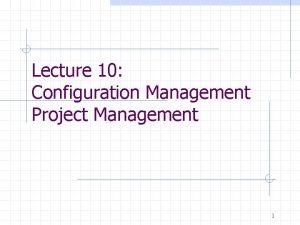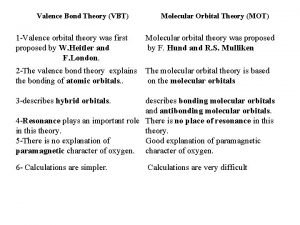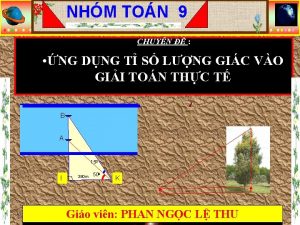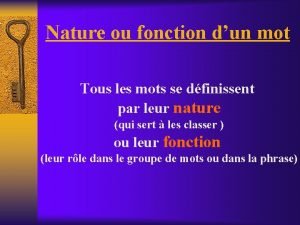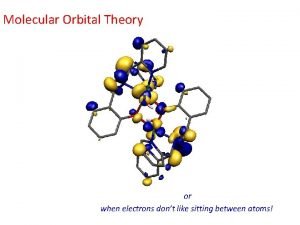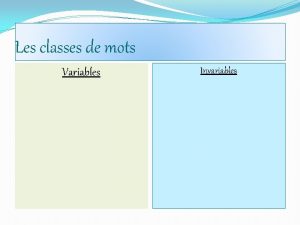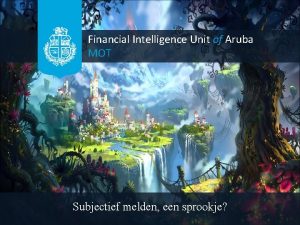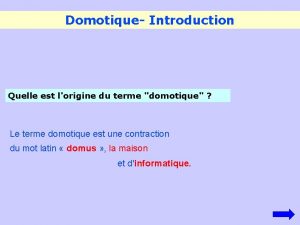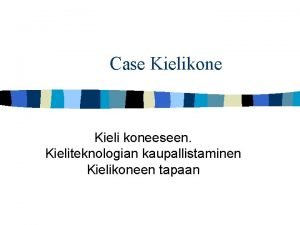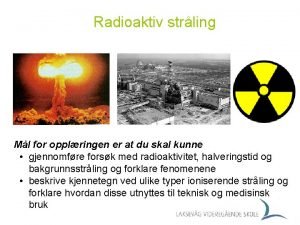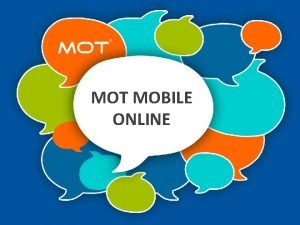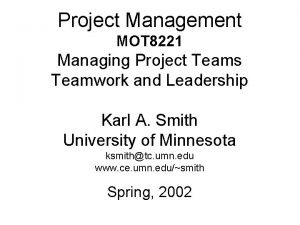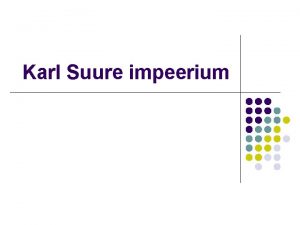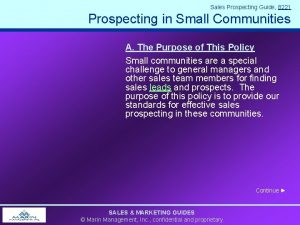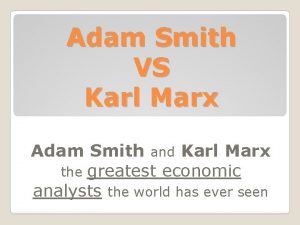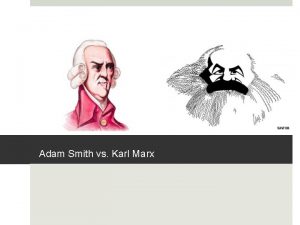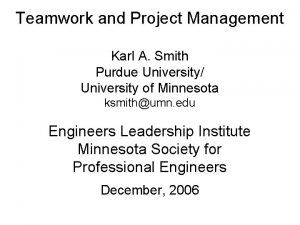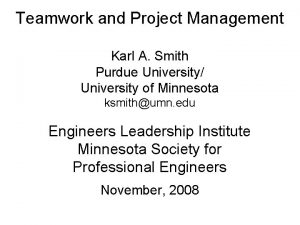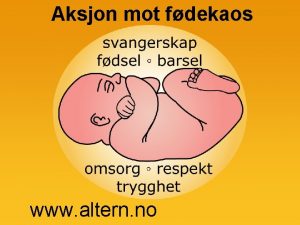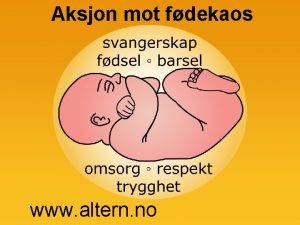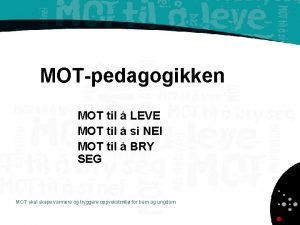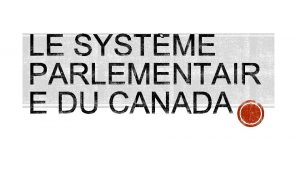Project Management MOT 8221 Karl A Smith University
























































- Slides: 56

Project Management MOT 8221 Karl A. Smith University of Minnesota ksmith@umn. edu www. ce. umn. edu/~smith Spring, 2002

Organization and Themes Organization 1. Technical aspects 2. Human aspects 3. Systems aspects 4. Emerging trends 5. 6. 7. 8. Themes Innovation/Creativity Synthesis/Design Learning

Objectives • To enhance the understanding of critical technical competencies in project management. • To understand the critical dimensions of project scope, time and cost management. • To enhance understanding of project management, important project manager roles and responsibilities, and keys to project success. • To build skills in working with the project management process. • To increase understanding of modern tools and techniques. • To apply the concepts and techniques.

RESOURCES Textbooks Lewis, James P. 2000. Project Planning, Scheduling & Control, 3 rd ed. Mc. Graw‑Hill; ISBN: 0071360506 Peters, Tom. 1999. The project 50: Fifty ways to transform every “task” into a project that matters! New York: Knopf. Also available in e. Book format (Palm, Windows CE, Pocket PC) at www. peanutpress. com. Smith, Karl A. 2000. Project Management & Teamwork (B. E. S. T. Series). Mc. Graw‑Hill Higher Education; ISBN: 0070122962 PMI Standards Committee. 1996. A guide to the project management body of knowledge. Upper Darby, PA: Project Management Institute (http: //www. pmi. org) (Available in PDF format from PMI web site or from www. ce. umn. edu/~smith) Reprints Computer Software Crit. Path for Windows. Available from Karl Smith or download from www. ce. umn. edu/~smith. 4

www. pmi. org PMBOK 5

Why project management? • “Those organizations that take project management seriously as a discipline, as a way of life, are likely to make it into the 21 st century. Those that do not are likely to find themselves in good company with dinosaurs. ” – Tom Peters 6

. . . Tomorrow’s corporation is a >collection of projects’. . . Everyone needs to learn to work in teams with multiple independent experts--each will be dependent upon all the others voluntarily giving their best. . The new lead actor/boss--the Project Manager --must learn to command coach; that is, to deal with paradox. From C Eight Commandments for Project Managers C Tom Peters

In the new economy, all work is project work. And you are your projects! Here’s how to make them all go Wow! Tom Peters – The Wow Project (Fast Company, 24, 116) 8

The Emerging Role of Project Management – William M. Hayden • Deming – Appreciation for a system – Knowledge about variation – Theory of knowledge – Psychology of individuals and groups • PMBOK • PMOS – Project Management Operating System 9

The Age of Project Management (Pinto and Kharbanda, 1995) 1. Shortened market windows and product life cycles. 2. Rapid development of third world and closed economies. 3. Increasingly complex and technical products. 4. Heightened international competition. 5. The environment of organizational resource scarcity. 10

Top Three Main Engineering Work Activities (Burton, Parker & Le. Bold, 1998) Civil/Architectural 1. Management – 45% 2. Design – 39% 3. Computer applications – 20% Engineering Total • Design – 36% • Computer applications – 31% • Management – 29% Burton, L. , Parker, L, & Le. Bold, W. 1998. U. S. engineering career trends. ASEE Prism, 7(9), 18 -21. 11

Management (Drucker, 1989) The fundamental task of management remains the same: to make people capable of joint performance through common goals, common values, the right structure, and the training and development they need to perform and to respond to change. Peter F. Drucker – The New Realities, 1989 12

Constructive Controversy Exercise Peter F. Drucker’s definition of management Sufficient – Pro Insufficient – Con 13

Project Management (Haynes, 1989) Project management focuses on a project. A project is an undertaking, that has a beginning and an end, and is carried out to meet established goals within cost, schedule and quality objectives. Project management brings together and optimizes the resources necessary to successfully complete the project. These resources include the skills, talents, and cooperative efforts of a team of people; facilities, tools and equipment; information, systems and techniques; and money. 14

What is a project? (Cleland Kerzner, 1985; Nicholas, 1990) • … a combination of human and nonhuman sources pulled together in a temporary organization to achieve a specified purpose. • Features – – – – Definable purpose with established goals Cost, time and performance requirements Multiple resources across organizational lines One-time activity Element of risk Temporary activity Process with phases/ project life cycle 15

A project is a one-time, multitask job with a definite starting point, definite ending point, a clearly defined scope of work, a budget, and usually a temporary team. Project management is facilitation of the planning, scheduling, and controlling of all activities that must be done to meet project objectives. The four project constraints: P, C, T & S Lewis (2000). 16

Project Management is not just scheduling (Lewis, p. 8) It’s the intersection of: Tools People Systems 17

Fundamental tools for the new generation of engineers and project managers…. • Systems/ systems thinking/ systems engineering • Models • Team work • Quality 18

What is a system? A system is a network of interdependent components that work together to try to accomplish the aim of the system (W. Edwards Deming. 1993. The new economics for industry, government, education. Cambridge, MA: MIT Center for Advanced Engineering Study) A system is a perceived whole whose elements "hang together" because they continually affect each other over time and operate toward a common purpose. The word descends from the Greek verb sunistánai, which originally meant “to cause to stand together. ” As this origin suggests, the structure of a system includes the quality of perception with which you, the observer, cause it to stand together. Examples of systems include biological organisms (including human bodies), the atmosphere, diseases, ecological niches, factories, chemical reactions, political entities, communities. industries, families, teams -- and all organizations. You and your work are probably elements of dozens of different systems. (Art Kleiner) Excerpted from The Fifth Discipline Fieldbook. Copyright 1994 by Peter M. Senge, Art Kleiner, Charlotte Roberts, Richard B. Ross, and Bryan J. Smith. http: //www. solonline. org/solonline/About_So. L/structure. html (Accessed 9/6/00) 19

Systems Approach (Churchman, C. West. 1968. The systems approach. New York: Laurel) Systems are made up of sets of components that work together for the overall objective of the whole. The systems approach is simply a way of thinking about these total systems and their components. Five basic considerations must be kept in mind when thinking about the meaning of a system: (1) the total systems objectives and the performance measures of the whole system, (2) the system’s environment; the fixed constraints, (3) the resources of the system; (4) the components of the system, their activities, goals and measures of performance; and (5) the management of the system. 20

Art & Practice of the Learning Organization 1. Building Shared Vision. The idea of building shared vision stresses that you never quite finish it--it's an ongoing process. 2. Personal Mastery. Learning organizations must be fully committed to the development of each individual's personal mastery--each individual's capacity to create their life the way they truly want. 3. Mental Models. Our vision of current reality has everything to do with the third discipline--mental models--because what we really have in our lives is constructions, internal pictures that we continually use of interpret and make sense out of the world. 4. Team Learning. Individual learning, no matter how wonderful it is or how great it makes us feel, if fundamentally irrelevant to organizations, because virtually all important decisions occur in groups. The learning unit of organizations are "teams, " groups of people who need one another to act. 5. Systems Thinking. The last discipline, the one that ties them all together, is systems thinking. Senge (In Ray & Rinzler, 1993) 21

Systems Thinking Systems thinking is a discipline for seeing wholes. It is a framework for seeing interrelationships rather than things, for seeing patterns of change rather than static "snapshots. " It is a set of principles and a set of specific tools and techniques. (Senge, 1990) Senge, Peter. 1990. The fifth discipline: The art and practice of the learning organization. New York: Doubleday. 22

Engineering Business, government, academic, or individual efforts in which knowledge of mathematics and/or natural science is employed in research, development, design, manufacturing, systems engineering, or technical operations with the objective of creating and/or delivering systems, products, processes, and/or services of a technical nature and content intended for use – National Research Council A scientist discovers that which exists. An engineer creates that which never was -- Theodore von Kármán (1881 -1963) Design in a major sense is the essence of engineering; it begins with the identification of a need and ends with a product or system in the hands of a user. It is primarily concerned with synthesis rather than the analysis which is central to engineering science. Design, above all else, distinguishes engineering from science (Hancock, 1986, National Science Foundation Workshop) 23

Engineering Approach - Exercise 24

Evolution of Models of Project Management Central Concept Era of Model Dominant Project Characteristics Main Thrust Metaphor Means Scheduling (Control) 1960 s Simple, Certain Coordinating activities Scheduling regional flights in an airline Information technology, Planning specialists Teamwork (Integration) 1970 s Complex, Certain Cooperation between participants Conducting a symphony orchestra Process facilitation, Definition or roles Reducing Uncertainty (Flexibility) 1980 s Complex, Uncertain Making stable decisions Exploring an unknown country Search for information, Selective redundancy Simultaneity (Dynamism) 1990 s Complex, Uncertain, Quick Orchestrating contending demands Directing a three-ring Experience, circus with continuous responsiveness and program modification based on live audience adaptability feedback

Era of Model 2000 s Central Concept? Dominant Project Characteristics? Main Thrust? Metaphor? Means? Discuss in your group.

Era of Model 2000 s MOT 8221 S 01 - Group 6 Central Concept? Virtual, non-linear, Dominant Project Characteristics? Leverage chaos Main Thrust? Melding innovation Metaphor? Adhocracy Means? Open-ended management

Era of Model 2000 s MOT 8221 S 01 - Group 4 + Central Concept? Global projects Dominant Project Characteristics? Cross -time, cross-geography Main Thrust? Parallelism Metaphor? Concurrent engineering on steroids Means? Electronic Sharing

Successful Projects 1. Take a moment to recall one of your most successful projects 2. Describe it briefly 3. Listen as others describe their successful projects 4. List common characteristics 29

A recent survey of technology projects in the United States by the Project Management Institute reveals some startling percentages. Close to half of the projects started were never finished, 30% were completed but took at least twice as long as expected, some took 5 times as long. Only 10% of the projects were finished on time.

Standish Group Survey of Software Project – 1994 (Lewis, 2000, p. 109) 17% Succeeded 50% Revised 33% Failed

Critical Success Factors and Their Importance for System Implementation (Listed in decreasing order of correlation) [Pinto (1986), See Smith (2000), p. 60] 1. Project mission. Initial clearly defined goals and general directions. 2. Top management support. Willingness of top management to provide the necessary resources and authority/power for implementation success. 3. Schedule plans. A detailed specification of the individual action steps for system implementation. 4. Client consultation. Communication, consultation, and active listening to all parties impacted by the proposed project. 5. Personnel. Recruitment, selection, and training of the necessary personnel for the implantation project team. 6. Technical tasks. Availability of the required technology and expertise to accomplish the specific technical action steps to bring the project on-line. 7. Client acceptance. The act of "selling" final product to its ultimate intended users. 8. Monitoring and feedback. Timely provision of comprehensive control information at each stage in the implementation process. 9. Communication. The provision of an appropriate network and necessary data to all key actors in the project implementation process. 10. Troubleshooting. Ability to handle unexpected crises and deviations from plan.

Predictors of Lowered Project Success William M. Hayden • Unrealistic project work plans • Inability to deal early with suspected problem issues • Technical complexities not well communicated to team members • Conflict between client expectations and the state of deliverables • Insufficient involvement on the part of senior management early in the life cycle

What is a project? (Cleland Kerzner, 1985; Nicholas, 1990) • … a combination of human and nonhuman sources pulled together in a temporary organization to achieve a specified purpose. • Features – – – – Definable purpose with established goals Cost, time and performance requirements Multiple resources across organizational lines One-time activity Element of risk Temporary activity Process with phases/ project life cycle 34

A project is a one-time, multitask job with a definite starting point, definite ending point, a clearly defined scope of work, a budget, and usually a temporary team. Project management is facilitation of the planning, scheduling, and controlling of all activities that must be done to meet project objectives. The four project constraints: P, C, T & S Lewis (2000). 35

Project Success: Quadruple Constraint

Types of Projects – Exploitation vs Exploration (March, 1991) Exploiting Old Ways: Organizing for Routine Work Drive out variance Exploring New Ways: Organizing for Innovative Work Enhance variance See old things in new ways Replicate the past See old things in new ways Break from the past Goal: Make money now Goal: Make money later March, J. G. 1991. Exploration and exploitation in organizational learning. Organizational Science, 2, 71 -87 37

Minute Paper – Reflection 1. Most interesting, valuable, useful thing you learned. 2. Question/Topic/Issue you would like to have addressed. 3. Comments, suggestions, etc. 38

Project Planning Projects typically start with at Statement of Work (SOW) provided by the client. The statement of work is a narrative description of the work required for the project. A Project Charter is often developed. Planning starts with the development of a Work Breakdown Structure (WBS). A WBS is ‘a deliverable-oriented grouping of project elements which organizes and defines the total scope of a project’ (PMBOK, 1996). There are typically three to six levels in WBSs -- program, project, task, subtask, etc. Developing a work breakdown structure is important for scoping a project, i. e. , determining the specific tasks that have to be completed, choosing appropriate groupings for these activities, and setting precedence and interdependence (what has to follow what and what can be going on at the same time).

www. lewisinstitute. com

Creating a Project Charter 1. Write an Overview of the Project Scope 2. Determine the Team’s Boundaries for Creating the Deliverables 3. Define the Customer’s Criteria for Acceptance 4. Determine the Required Reviews and Approvals 5. Establish Risk Limits 6. Select the Project Leader and Team Members 7. Set Deadlines for Delivery of the Final Deliverables 8. Set Limits on Staffing & Spending 9. Create a List of Required Reports 10. Identify Organizational Constraints & Project Priorities. 11. Assemble a Project Charter Martin, P. & Tate, K. 1997. Project Management Memory Jogger. GOAL/QPC.

charterform. pdf 42

Office Remodeling Project The following activities must be accomplished to complete an office remodeling project: Activity Estimated Duration (Days) Procure Paint 2 Procure New Carpet 5 Procure New Furniture 7 Remove Old Furniture 1 Remove Old Carpet 1 Scrub Walls 1 Paint Walls 2 Install New Carpet 1 Move in New Furniture 1

Office Remodeling Project - WBS Procure Paint Procure New Carpet Procure New Furniture Prepare Remove Old Furniture Remove Old Carpet Scrub Walls Install Paint Walls Install New Carpet Move in New Furniture

45

46

Scheduling Problem - CPM Bus Shelter Construction Example Job Name Duration Resources Predecessor(s) 1 Shelter Slab 2 2 5 2 Shelter Walls 1 1 1 3 Shelter Roof 2 2 2, 4 4 Roof Beam 3 2 2 5 Excavation 2 3 6 Curb and Gutter 2 3 5 7 Shelter Seat 1 2 4, 6 8 Paint 1 1 7 9 Signwork 1 2 2, 6

48


Bus Shelter Construction Critical Path Method Results ACT NAME DUR RES LATE EARLY FLOAT ST FN TOT FREE CUR CRIT start PATH 1 Shelter Slab 2 2 2 4 0 0 2 YES 2 Shelter Walls 1 1 4 5 0 0 4 YES 3 Shelter Roof 2 2 8 10 0 0 8 YES 4 Roof Beam 3 2 5 8 0 0 5 YES 5 Excavation 2 3 0 2 0 0 0 YES 6 Curb and Gutter 2 3 2 4 6 8 4 1 2 NO 7 Shelter Seat 1 2 8 9 0 0 8 YES 8 Paint 1 1 9 10 0 0 9 YES 9 Signwork 1 2 5 6 9 10 4 4 5 NO

Estimating Activity Duration 1. Activity length between 0. 5% and 2% of project duration. If an activity takes a year, each activity should be between a day and a week. 2. Critical activities that fall below this range should be included. 3. If the number of activities is very large (say, above 250), the project should be divided into subprojects, and individual schedules developed for each.

Homework Assignment 1 Develop a Statement of Work (SOW), a Project Charter, and Complete a Work Breakdown Structure (WBS) and a Critical Path Schedule for a project (or subproject) from your workplace or experience

Characteristics of ‘Effective’ Project Managers? 1. Formulate your response to the question individually 2. Share your answer with a neighbor 3. Listen carefully to your neighbor's answer 4. Work together to Create a new answer through discussion

What is takes to be a good project manager --Barry Posner (1987) Communications (84% of the respondents listed it) Listening Persuading Organizational skills (75%) Planning Goal-setting Analyzing Team Building Skills (72%) Empathy Motivation Esprit de Corps Leadership Skills (68%) Sets Example Energetic Vision (big picture) Delegates Positive Coping Skills (59%) Flexibility Creativity Patience Persistence Technological Skills (46%) Experience Project Knowledge

Skills necessary for effective project managers -Pinto and Kharbanda (1995): Planning • Work breakdown • Project scheduling • Knowledge of PM software • Budgeting and costing Organizing • Team building • Establishing team structure and reporting assignments • Define team policies, rules and protocols Leading • Motivation • Conflict management • Interpersonal skills • Appreciation of team members' strengths and weaknesses • Reward systems Controlling • Project review techniques • Meeting skills

Keys to success as a project manager--Lientz and Rea (1996): • Communicate regularly in person with key team members • Keep management informed • Keep informed on all aspects of the project • Delegate tasks to team members • Listen to input from team members • Be able to take criticism • Respond to and/or act on suggestions for improvement • Develop contingency plans • Address problems • Make decisions • Learn from past experience • Run an effective meeting • Set up and manage the project file • Use project management tools to generate reports • Understand trade-offs involving schedule and budget • Have a sense of humor
 Compare and contrast, karl marx and adam smith venn diagram
Compare and contrast, karl marx and adam smith venn diagram Adam smith vs karl marx
Adam smith vs karl marx Traditional project management vs modern project management
Traditional project management vs modern project management Mot management of technology
Mot management of technology Mot management of technology
Mot management of technology Project management university of pretoria
Project management university of pretoria Rasic chart
Rasic chart Faculty management system project report
Faculty management system project report The role of project management in achieving project success
The role of project management in achieving project success Modern process transitions in spm
Modern process transitions in spm Cost duration graph
Cost duration graph Modern project management began with what project
Modern project management began with what project What is strategic assessment in software project management
What is strategic assessment in software project management Types of project audit in project management
Types of project audit in project management Agile ms project template
Agile ms project template Varieties of project termination
Varieties of project termination Diagnosis
Diagnosis Managing assets vs asset management
Managing assets vs asset management Configuration management system pmp
Configuration management system pmp Principles of project cost management
Principles of project cost management Ieee 828
Ieee 828 Project integration management
Project integration management 詹景裕
詹景裕 Top management middle management first line management
Top management middle management first line management Management pyramid
Management pyramid Top level management
Top level management Valence bond theory and molecular orbital theory
Valence bond theory and molecular orbital theory 2 nghìn đồng
2 nghìn đồng Một đời lần trong đêm tối
Một đời lần trong đêm tối Một học sinh cận thị có các điểm cc cv
Một học sinh cận thị có các điểm cc cv Hai ngư dân đứng bên một bờ sông cách nhau 250m
Hai ngư dân đứng bên một bờ sông cách nhau 250m Quan sát một ảnh lễ hội
Quan sát một ảnh lễ hội Nature du mot du
Nature du mot du Px py pz orbitals
Px py pz orbitals 250 mot
250 mot Organisateurs textuel
Organisateurs textuel Un mot variable
Un mot variable Argumenterande tal
Argumenterande tal Một người ăn xin đã già
Một người ăn xin đã già Mot aruba
Mot aruba Quelle est le role de la domotique
Quelle est le role de la domotique Một vành giếng có hình như hình vẽ
Một vành giếng có hình như hình vẽ Mot sanakirja hy
Mot sanakirja hy Alpha omega a part toi il nya point d'autre dieu
Alpha omega a part toi il nya point d'autre dieu Bienvenue au culte d'adoration
Bienvenue au culte d'adoration Pour cet immense bonheur alléluia
Pour cet immense bonheur alléluia Argumenterande text kärnkraft
Argumenterande text kärnkraft Hur man skriver ett argumenterande tal
Hur man skriver ett argumenterande tal Stanford prison experiment slutsats
Stanford prison experiment slutsats đan nong mốt sáng tạo
đan nong mốt sáng tạo Mot sanakirja aalto
Mot sanakirja aalto Hva er alfastråling
Hva er alfastråling Nho2
Nho2 Mot online
Mot online Le voyage chanson
Le voyage chanson Lệnh tìm kiếm đơn giản trong access
Lệnh tìm kiếm đơn giản trong access Jeu de mot couleur
Jeu de mot couleur
